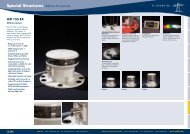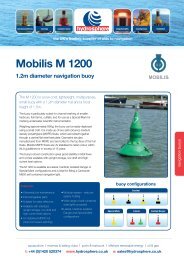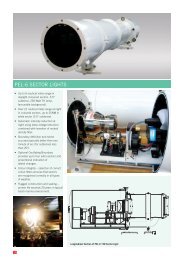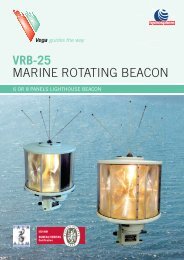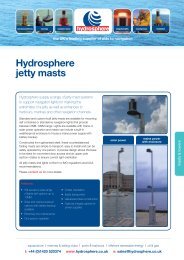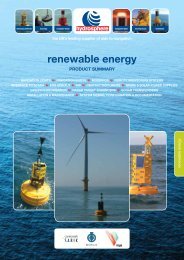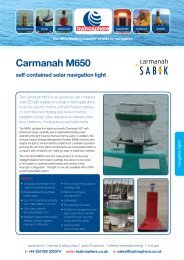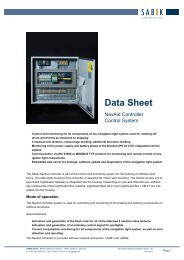for the Marking of Fixed Bridges over Navigable Waters
for the Marking of Fixed Bridges over Navigable Waters
for the Marking of Fixed Bridges over Navigable Waters
You also want an ePaper? Increase the reach of your titles
YUMPU automatically turns print PDFs into web optimized ePapers that Google loves.
Recommendation O-113 - on <strong>the</strong> <strong>Marking</strong> <strong>of</strong> <strong>Fixed</strong> <strong>Bridges</strong> <strong>over</strong> <strong>Navigable</strong> <strong>Waters</strong>May 1998 – Revised July 2005Document RevisionsRevisions to <strong>the</strong> IALA Document are to be noted in <strong>the</strong> table prior to <strong>the</strong> issue <strong>of</strong> arevised document.Date Page / Section Revised Requirement <strong>for</strong> RevisionJuly 2005 Entire doc re<strong>for</strong>matted Re<strong>for</strong>matting to meet IALAdocumentation standardsPage 2 <strong>of</strong> 6
Recommendation O-113 - on <strong>the</strong> <strong>Marking</strong> <strong>of</strong> <strong>Fixed</strong> <strong>Bridges</strong> <strong>over</strong> <strong>Navigable</strong> <strong>Waters</strong>May 1998 – Revised July 2005IALA Recommendation O-113 on <strong>the</strong> <strong>Marking</strong> <strong>of</strong> <strong>Fixed</strong><strong>Bridges</strong> <strong>over</strong> <strong>Navigable</strong> <strong>Waters</strong>(IALA Recommendation O-113, May, 1998)THE COUNCIL:RECOGNISING <strong>the</strong> need to provide guidance on <strong>the</strong> marking <strong>of</strong> fixed bridges <strong>over</strong>navigable waters which is compatible with <strong>the</strong> IALA Maritime Buoyage System;RECOGNISING ALSO that such guidance should enable a common approach to bemade world-wide, thus greatly assisting mariners, who, while navigating in waters <strong>of</strong>different authorities, should not be confused by different marking systems being usedon fixed bridges;CONSIDERING <strong>the</strong> proposals <strong>of</strong> <strong>the</strong> IALA Operational Committee;REVOKES IALA Recommendation <strong>for</strong> <strong>the</strong> marking <strong>of</strong> fixed bridges <strong>over</strong> navigablewaters, dater 14 th May, 1987; and,RECOMMENDS that:1 GENERALThe following recommendations should be read in conjunction with <strong>the</strong> IALA MaritimeBuoyage System. They are intended to supplement <strong>the</strong> rules <strong>of</strong> <strong>the</strong> system wherebridges need special marking to ensure <strong>the</strong>ir safety and that <strong>of</strong> vessels navigatingbeneath <strong>the</strong>m, <strong>for</strong> example by reason <strong>of</strong> limited headroom, water depth or <strong>the</strong>possibility <strong>of</strong> collision with <strong>the</strong> bridge piers.Where sea and inland navigation meet, authorities should ensure that <strong>the</strong> marking <strong>of</strong>bridges does not conflict with <strong>the</strong> signs and signals <strong>of</strong> inland waterways systems.2 BEST POINT OF PASSAGEIn some cases, it may be necessary or desirable to indicate to vessels <strong>the</strong> mostappropriate point to pass under a bridge. This is referred to in this Recommendationas “best point <strong>of</strong> passage”.These recommendations provide suitable day and night signals <strong>for</strong> this purpose.The “best point <strong>of</strong> passage” will be determined by <strong>the</strong> competent Authority taking intoaccount all relevant factors, such as:• maximum available headroom• water depth under <strong>the</strong> bridge, particularly where it is not uni<strong>for</strong>m• protection <strong>of</strong> <strong>the</strong> bridge piers and o<strong>the</strong>r obstructions• <strong>the</strong> need to have one way or two way traffic.Page 3 <strong>of</strong> 6
Recommendation O-113 - on <strong>the</strong> <strong>Marking</strong> <strong>of</strong> <strong>Fixed</strong> <strong>Bridges</strong> <strong>over</strong> <strong>Navigable</strong> <strong>Waters</strong>May 1998 – Revised July 20053 VISUAL MARKSThe following system is recommended when proceeding in <strong>the</strong> “ConventionalDirection <strong>of</strong> Buoyage”.3.1 Colours (<strong>for</strong> daymarks and lights)3.1.1 In countries in Buoyage Region A• Green to starboard• Red to Port.3.1.2 In countries in Buoyage Region B• Red to starboard• Green to Port.3.2 <strong>Marking</strong> by day (if considered necessary)3.2.1 If navigation is possible in <strong>the</strong> full passage span. <strong>the</strong> marks should be locatedon <strong>the</strong> bridge piers. If navigation is possible only in part <strong>of</strong> <strong>the</strong> span, <strong>the</strong> marksshould be located on or under <strong>the</strong> span, indicating <strong>the</strong> limits <strong>of</strong> <strong>the</strong> navigablechannel.• In countries in Buoyage Region Ao to starboard: a panel showing a solid green equilateral triangle pointupwards.o to port: a panel showing a solid red square.• In countries in Buoyage Region Bo to starboard: a panel showing a solid red equilateral triangle pointupwards.o to port: a panel showing a solid green square.3.2.2 The “best point <strong>of</strong> passage” may be indicated by a circular panel with red andwhite vertical stripes.3.2.3 To ensure positive recognition, <strong>the</strong> Competent. Authority should be satisfiedthat <strong>the</strong>re is a good contrast between <strong>the</strong> coloured panels and <strong>the</strong> colour <strong>of</strong><strong>the</strong> bridge structure. Such a contrast may be achieved by mounting <strong>the</strong> panelsagainst a white background.3.2.4 If <strong>the</strong>re is more than one navigable channel under <strong>the</strong> bridge, <strong>the</strong> samesystem should be used <strong>for</strong> each channel.3.2.5 Bridge spans o<strong>the</strong>r than those marked by red and green lateral marks, e.g.spans to be used by very small craft, may be indicated by special yellowmarks as prescribed in <strong>the</strong> IALA Maritime Buoyage System.Page 4 <strong>of</strong> 6
Recommendation O-113 - on <strong>the</strong> <strong>Marking</strong> <strong>of</strong> <strong>Fixed</strong> <strong>Bridges</strong> <strong>over</strong> <strong>Navigable</strong> <strong>Waters</strong>May 1998 – Revised July 20053.3 <strong>Marking</strong> by night3.3.1 Red or green rhythmic aid to navigation lights may be used to mark <strong>the</strong>navigable limits <strong>of</strong> <strong>the</strong> channel in accordance with <strong>the</strong> IALA Maritime BuoyageSystem.If navigation is possible in <strong>the</strong> full passage span, <strong>the</strong> lights should be located on <strong>the</strong>bridge piers. If navigation is possible only in a part <strong>of</strong> <strong>the</strong> span, <strong>the</strong> lights should belocated under <strong>the</strong> span, or on buoy and beacons in <strong>the</strong> water so placed as to indicate<strong>the</strong> limits <strong>of</strong> <strong>the</strong> navigable channel.3.3.2 The “best point <strong>of</strong> passage” may be indicated by a white light or lights locatedunder <strong>the</strong> span and exhibiting a safe water mark character.3.3.3 If <strong>the</strong>re is more than one navigable channel under <strong>the</strong> bridge, <strong>the</strong> samesystem should be used <strong>for</strong> each channel.3.3.4 Care should be taken to ensure that all red and green aid to navigation lightshave adequate ranges having regard to <strong>the</strong> circumstances, especially wherebackground lighting makes identification difficult. The lights must be somounted as to be visible <strong>over</strong> all relevant areas <strong>of</strong> <strong>the</strong> horizon, and notobstructed by parts <strong>of</strong> <strong>the</strong> bridge structure.3.3.5 Bridge spans o<strong>the</strong>r than those marked by red and green lateral, e.g. spans tobe used by very small craft, may be indicated by special yellow lights asprescribed in <strong>the</strong> IALA Maritime Buoyage System.3.3.6 As an alternative to aid to navigation lights, <strong>the</strong> daymarks prescribed inparagraphs 3.2.1. and 3.2.2. may be floodlit.3.3.7 Floodlighting <strong>of</strong> bridge piers may in some cases give a satisfactory indication<strong>of</strong> <strong>the</strong> navigable area and may be considered.3.3.8 Retroreflecting material <strong>of</strong> appropriate colour may be used to enhance nighttime recognition <strong>of</strong> daymark panels.4 SOUND SIGNALSOne or more sound fog signals may be used to warn <strong>the</strong> navigator <strong>of</strong> <strong>the</strong> presence <strong>of</strong>a bridge.Any type <strong>of</strong> sound fog signal may be used <strong>for</strong> this purpose.If a number <strong>of</strong> sound fog signals are placed at different points on a bridge or itssupports, <strong>the</strong>ir characters should be different from each o<strong>the</strong>r.5 RADAR MARKING5.1 Radar reflectors<strong>Bridges</strong> crossing navigable water are usually clearly recognizable on a radar display.However channel boundaries or bridge piers are seldom clearly distinguishable.Radar recognition <strong>of</strong> <strong>the</strong> bridge piers or channel boundaries may be made possibleby radar reflectors located ei<strong>the</strong>r on dolphins, on buoys or on poles fixed to <strong>the</strong>Page 5 <strong>of</strong> 6
Recommendation O-113 - on <strong>the</strong> <strong>Marking</strong> <strong>of</strong> <strong>Fixed</strong> <strong>Bridges</strong> <strong>over</strong> <strong>Navigable</strong> <strong>Waters</strong>May 1998 – Revised July 2005bridge structure. Radars on sea going vessels are usually such that <strong>the</strong> distancebetween <strong>the</strong> bridge and <strong>the</strong> reflectors should be 20 metres or more. To ensure that<strong>the</strong> reflectors can be clearly distinguished from <strong>the</strong> bridge structure, practical trialsshould be carried out.5.2 RaconsA short range racon may be used to mark <strong>the</strong> “best point <strong>of</strong> passage” under a bridge.Administrations contemplating <strong>the</strong> use <strong>of</strong> more than one racon to mark one or morespans must take into account <strong>the</strong> technical limitations that may exist. Where tworacons are used to mark a bridge span <strong>the</strong> preferred codes should be:• Starboard: Morse code T(-)• Port: Morse code B(-···)Care should be taken to ensure that <strong>the</strong> racon trace does not unnecessarily obscureechoes from o<strong>the</strong>r targets.Page 6 <strong>of</strong> 6



